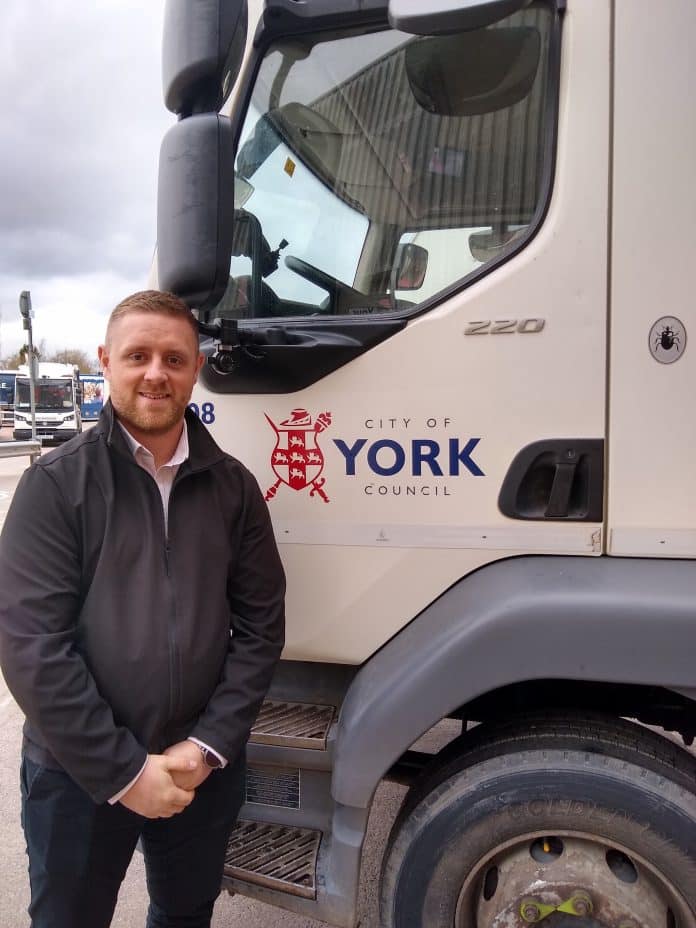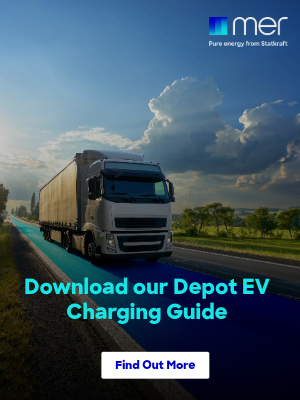With pre-Roman origins, York is one of the most historic cities in Europe. Today, the main city and surrounding areas has a population of over 200,000 and services are provided by the City of York Council Unitary Authority.
The diverse vehicle fleet that supports those services is undergoing changes that will meet the strategic objective of carbon neutrality by 2030 and Ian Hoult, Head of Fleet at the City of York tells Essential Fleet Manager how this will be achieved in very challenging times.
Q: Could you describe the fleet make-up that you saw on joining the Council in 2019 and what were the most immediate challenges?
The City of York Council (CYC) fleet was made up of a typical diverse local authority fleet, capable of delivering many services to the public. Consisting of 230 vehicles with a split of 60 HGVs and 170 cars, vans and light commercials – the majority being diesel. Almost 95% of the fleet was age expired, so had exceeded its life expectancy.
In addition to this, there were also 300 pieces of plant equipment ranging from small hand held items to large plant. With these assets needing more frequent repairs and the Council’s ambition to be carbon neutral by 2030, a full review of the Councils fleet replacement programme was immediately required – a huge undertaking.
Q: After conducting a fleet review, what were the main options to be considered before settling on the formal strategy and what are the key aims of the strategy?
Once we had reviewed the fleet assets and understood the base fleet in each of the user departments, we could then begin to look at viable options incorporating the Council’s environmental ambitions.
We developed a report with three viable options for our chief officers to present to our executive members. When the preferred option was chosen, we created a strategy to replace the fleet that met the Council’s environmental ambitions and users need.
Considering the expected life span for our HGV fleet is seven years, we opted to replace this section of the fleet with Euro 6 diesels immediately, with the exception of two HGV refuse collection vehicles that would become full Battery Electric Vehicles (BEVs). By doing this, we thought it allowed other technologies such as hydrogen fuel cells to be further developed, hopefully creating other options for us from 2028 and onwards, at which point our HGVs would be due for replacement again.
The rest of the vehicles on the fleet, including anything up to 3500kg would be replaced with full BEVs. This in on course to be completed by 2024/25.
There were two key aims of this strategy; to meet our ambitious target by 2030 and to continue our delivery of the many services a unitary authority provides.
Q: A huge part of your plan is to transition the entire vehicle fleet up to 3.5T to EVs. Even on the most basic level this is a complex process, but how have you been meeting the additional challenges of the last 2 years?
The past two years have been challenging for everyone on all fronts, but one of the biggest challenges we have faced, is the uncertainty of vehicle delivery times for the orders placed.
This has been more apparent in the last 12 months, as during 2020 we were concentrating on creating our fleet replacement strategy and how we would meet our targets.
COVID obviously proved challenging, but in terms of fleet procurement and deliveries, the worldwide shortage of microchips due to the main factory blaze where they are made and Brexit, I believe, have played as big as part as anything; it’s been the ‘perfect storm’.
All we have done, and continue to do so, is to have honest open relationships with manufacturers and suppliers from the outset. We make our expected delivery times very clear in our procurement frameworks and will use these delivery times as part of our award criteria.
We are now finding that manufacturers are broadly the same in terms of expected delivery, but as the ball is in their court this creates an edge of competitiveness between the suppliers.
Interestingly however, some Electric Vehicle (EV) orders have not taken as long as the diesel versions, for example the electric refuse vehicles we ordered were delivered before the Euro 6 variants, even though we ordered them at the same time. I think this could be because CYC is ahead of the curve compared to some organisations who are still ordering fossil fuelled vehicles which is maybe a more crowded market.
Q: How has data led technology, such as telematics, helped inform your decisions?
Telematics have been a really important tool for us. We have analysed our vehicle tracking mileage data to ensure our services can operate effectively under the new EV model.
We used telematics data in addition to our back office fuel management system at the beginning, to demonstrate some economic efficiencies, but this was not one of the main drivers behind converting to an EV fleet for the majority of our assets.
We did however use our fuel management tools to understand our carbon output from the tail pipe and will continue to do this in the years to come to show the reduction in our emissions.
Q: How are you ensuring that there is the EV charging infrastructure that will meet all the needs of your fleet now and in the future?
I have worked with our internal Fleet Management and Transport teams who have liaised with Northern Power Grid (NPG) externally to be sure we can generate enough power in our operational depot.
Our Transport team have procured a supplier to implement the infrastructure to ensure our vehicle charging needs are met. There has essentially been three phases; Stage one 2020 upgrade to our existing depot infrastructure and sub-station; Stage two 2021/22 implement 70 fast chargers and 10 rapid chargers with load balancing; Stage three 2023 build a new sub-station at our site capable of increasing the power output and upgrade the number of rapid chargers.
Once we analysed our telematics data we confirmed what we already broadly knew, due to the demographics of York, the mileage the vehicles were travelling on any given day was not high – this the enabled us to make the decision to avoid home charging altogether. We have circa 90 vehicles that undertake ‘home start’ duties and therefore this was a key decision.
But what the analysis of the telematics showed was that the number of trips required to re-charge would be very similar to the number of trips made to re-fuel or other visits made for re-stocking of parts for our trades teams. This gave us the opportunity to operate a different re-charging model compared to other organisations, mitigating risk and overcoming the known home charging challenges, as well as making financial savings.
Vehicles on home start duties will use the rapid chargers between the hours of 8am – 5pm and then the vehicles parked at the depot overnight will use the fast chargers between 5pm – 8am. The previously mentioned load balancing technology will distribute the power accordingly until our new sub-station is built next year and then charging anything at any point shouldn’t be a challenge.
Q: What are the options and challenges when “decarbonising” heavier vehicle assets such as RCVs?
The availability of such vehicles and the massive cost difference between an alternative fuelled version and the diesel variant.
Also the technology for the heavier fleet isn’t quite as advanced as the smaller EVs, so this required careful consideration to ensure operationally, nothing changes.
Q: How can Government and other agencies better assist and support organisations in England that have committed to low emission fleet operations?
Initiatives through central funding, such as the Government grants available through OLEV are welcomed, but not sufficient for an organisation the size of CYC or greater.
My understanding is that Transport for Scotland offers bridging from the diesel cost to the EV cost. In Wales a recycling initiative to re-power HGVs is currently in place that offers greater financial incentives. These are both great initiatives and no doubt proving successful with organisations who are taking advantage of these schemes.
CYC have and are investing heavily in BEV technology along with the infrastructure and have had very little back in terms of incentives. Climate change is at the forefront of most organisations and businesses both public and private sector so if this and future Governments want to accelerate the lowering of carbon footprints then new incentive gains need to be offered; these don’t have to be necessarily financial.
Q: How important are expert suppliers and other outside partners to effectively managing the targets and objectives of your fleet management policy and strategy?
Our fleet team at CYC engaged with other external organisations at the beginning of our fleet replacement journey and this proved invaluable. It helped us to learn from those organisations as we were able to make use of shared knowledge.
Suppliers are helpful with sharing advice and are really reassuring with the warranty periods offered.
Two things that are difficult to predict are the life expectancy of the assets, and then the residual value at end of life. In terms of life expectancy, we would like these to be greater than what we would base our fossil fuelled vehicles on due to the capital investment. In 5-7 years’ time it is difficult to predict what the market will look like, which can make budgeting whole life costs difficult.
Q: How far do you think Battery Electric Vehicles will be improved and do you see a greater role for Hydrogen Fuel Cell Electric Vehicles in the future?
Technology is improving all the time and because more organisations are taking the plunge into the BEV world it is forcing manufacturers to improve more rapidly therefore creating a more competitive market. Personally I see hydrogen fuel cells being a big player in the HGV sector and speaking to other freight partners they feel the same. This was my advice when devising the fleet replacement strategy and I still firmly believe it, there needs to be further work and time invested into the feasibility of hydrogen fuelling stations and the locations in the UK; this again is where central government could offer support. In terms of hydrogen fuelled vehicles, manufacturers in Japan and Germany are making great progress. There is also the argument for hydrogen to fuel EV infrastructure and that feasibility.
Q: How is the City of York setting the pace and providing learning opportunities for other authorities and organisations?
When I shared with colleagues in 2020 from other organisations that CYC was moving towards an EV fleet imminently and would no longer procure fossil fuelled vehicles up to 3500kg, I think they were very surprised. But now many organisations especially in the public sector have short dates to meet in terms of their environmental impact and become carbon neutral. I am contacted all the time by colleagues in other authorities asking for information, data, best procurement methods, and just general advice which I am more than happy to share.
I know how difficult these strategies are and especially managing the expectation of the Council. It is very pleasing for CYC to be recognised as the pace setters and leading in terms of local authority fleet carbon neutralisation. We just need to keep to our strategy in the most linear way possible and place trust in the technology; if we can do that then I am confident we will meet our target.
We are also investing heavily into our workforce with every category B license holder going through the five hours AFV training even if they won’t be driving BEVs over 3500kg just to give them an element of driving an alternative fuelled vehicle. We have trained all our engineers up to Level three hybrid and electrical maintenance to firstly ensure their safety and continue with our in-house maintenance model.
This feature was in Essential Fleet Manager Issue 3 (2022)





